
FlagEmbedding
Retrieval and Retrieval-augmented LLMs
Stars: 10587
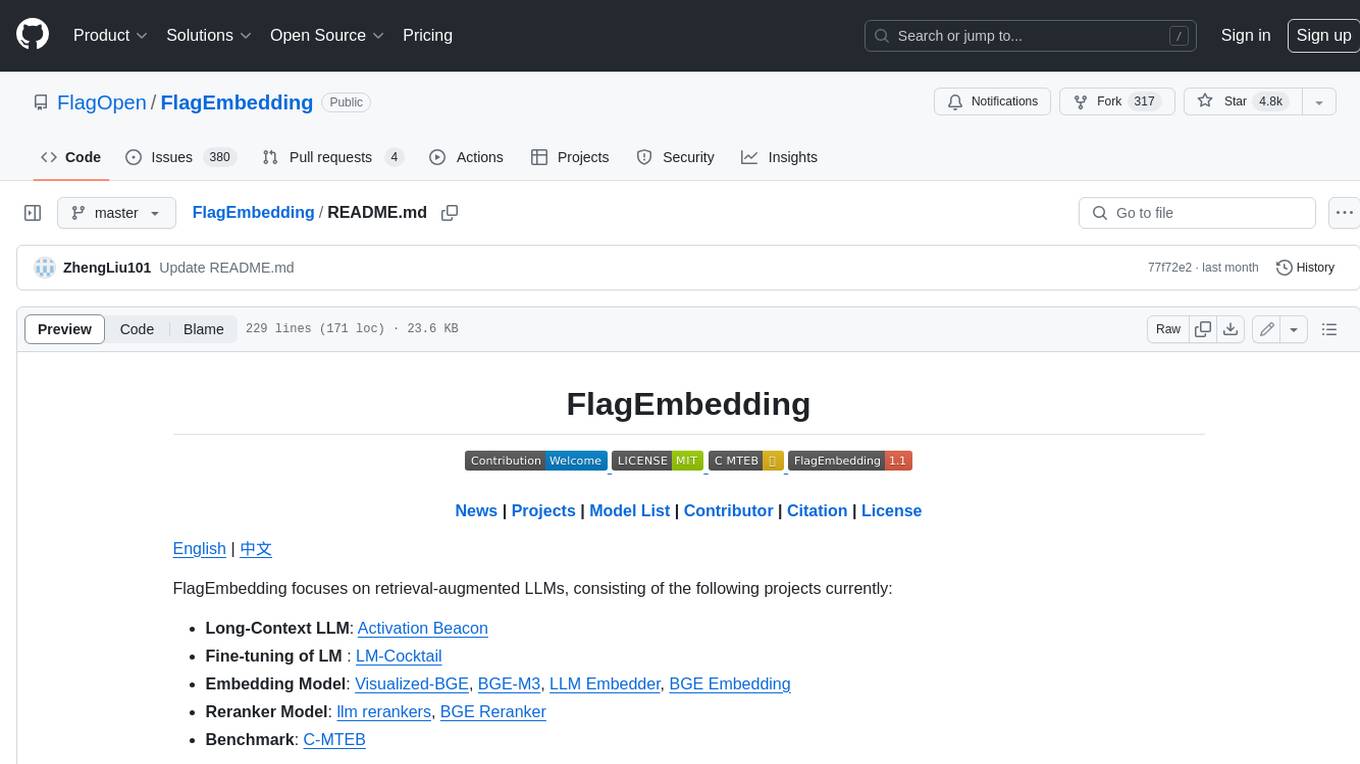
FlagEmbedding focuses on retrieval-augmented LLMs, consisting of the following projects currently: * **Long-Context LLM** : Activation Beacon * **Fine-tuning of LM** : LM-Cocktail * **Embedding Model** : Visualized-BGE, BGE-M3, LLM Embedder, BGE Embedding * **Reranker Model** : llm rerankers, BGE Reranker * **Benchmark** : C-MTEB
README:
News | Installation | Quick Start | Community | Projects | Model List | Contributor | Citation | License
-
3/6/2025: 🔥🔥 Introduce BGE-VL (HF repo), State-Of-The-Art multimodal embedding models to support Any visual search applications (everything, including text-to-image, image-to-text, image&prompt-to-image, text-to-image&text, and more)! They are released under the MIT license and are completely free for both academic and commercial use. We also release MegaPairs (repo, paper), a massive synthetic dataset which empowers BGE-VL!
-
12/5/2024: 📖 We built the BGE documentation for centralized BGE information and materials!
-
10/29/2024: 🌏 We created WeChat group for BGE. Scan the QR code to join the group chat! To get the first hand message about our updates and new release, or having any questions or ideas, join us now!
-

-
10/22/2024: We release another interesting model: OmniGen, which is a unified image generation model supporting various tasks. OmniGen can accomplish complex image generation tasks without the need for additional plugins like ControlNet, IP-Adapter, or auxiliary models such as pose detection and face detection.
-
9/10/2024: Introducing MemoRAG, a step forward towards RAG 2.0 on top of memory-inspired knowledge discovery (repo: https://github.com/qhjqhj00/MemoRAG, paper: https://arxiv.org/pdf/2409.05591v1)
-
9/2/2024: Start to maintain the tutorials. The contents within will be actively updated and eariched, stay tuned! 📚
-
7/26/2024: Release a new embedding model bge-en-icl, an embedding model that incorporates in-context learning capabilities, which, by providing task-relevant query-response examples, can encode semantically richer queries, further enhancing the semantic representation ability of the embeddings.
-
7/26/2024: Release a new embedding model bge-multilingual-gemma2, a multilingual embedding model based on gemma-2-9b, which supports multiple languages and diverse downstream tasks, achieving new SOTA on multilingual benchmarks (MIRACL, MTEB-fr, and MTEB-pl).
-
7/26/2024: Release a new lightweight reranker bge-reranker-v2.5-gemma2-lightweight, a lightweight reranker based on gemma-2-9b, which supports token compression and layerwise lightweight operations, can still ensure good performance while saving a significant amount of resources. 🔥
More
- 6/7/2024: Release a new benchmark MLVU, the first comprehensive benchmark specifically designed for long video understanding. MLVU features an extensive range of video durations, a diverse collection of video sources, and a set of evaluation tasks uniquely tailored for long-form video understanding. 🔥
- 5/21/2024: Release a new benchmark AIR-Bench together with Jina AI, Zilliz, HuggingFace, and other partners. AIR-Bench focuses on a fair out-of-distribution evaluation for Neural IR & RAG. It generates the synthetic data for benchmarking w.r.t. diverse domains and languages. It is dynamic and will be updated on regular basis. Leaderboard 🔥
- 4/30/2024: Release Llama-3-8B-Instruct-80K-QLoRA, extending the context length of Llama-3-8B-Instruct from 8K to 80K via QLoRA training on a few synthesized long-context data. The model achieves remarkable performance on various long-context benchmarks. Code 🔥
- 3/18/2024: Release new rerankers, built upon powerful M3 and LLM (GEMMA and MiniCPM, not so large actually 😃) backbones, supporitng multi-lingual processing and larger inputs, massive improvements of ranking performances on BEIR, C-MTEB/Retrieval, MIRACL, LlamaIndex Evaluation 🔥
- 3/18/2024: Release Visualized-BGE, equipping BGE with visual capabilities. Visualized-BGE can be utilized to generate embeddings for hybrid image-text data. 🔥
- 1/30/2024: Release BGE-M3, a new member to BGE model series! M3 stands for Multi-linguality (100+ languages), Multi-granularities (input length up to 8192), Multi-Functionality (unification of dense, lexical, multi-vec/colbert retrieval). It is the first embedding model which supports all three retrieval methods, achieving new SOTA on multi-lingual (MIRACL) and cross-lingual (MKQA) benchmarks. Technical Report and Code. 🔥
- 1/9/2024: Release Activation-Beacon, an effective, efficient, compatible, and low-cost (training) method to extend the context length of LLM. Technical Report
- 12/24/2023: Release LLaRA, a LLaMA-7B based dense retriever, leading to state-of-the-art performances on MS MARCO and BEIR. Model and code will be open-sourced. Please stay tuned. Technical Report and Code
- 11/23/2023: Release LM-Cocktail, a method to maintain general capabilities during fine-tuning by merging multiple language models. Technical Report
- 10/12/2023: Release LLM-Embedder, a unified embedding model to support diverse retrieval augmentation needs for LLMs. Technical Report
- 09/15/2023: The technical report of BGE has been released
- 09/15/2023: The massive training data of BGE has been released
- 09/12/2023: New models:
-
New reranker model: release cross-encoder models
BAAI/bge-reranker-baseandBAAI/bge-reranker-large, which are more powerful than embedding model. We recommend to use/fine-tune them to re-rank top-k documents returned by embedding models. -
update embedding model: release
bge-*-v1.5embedding model to alleviate the issue of the similarity distribution, and enhance its retrieval ability without instruction.
-
New reranker model: release cross-encoder models
- 09/07/2023: Update fine-tune code: Add script to mine hard negatives and support adding instruction during fine-tuning.
- 08/09/2023: BGE Models are integrated into Langchain, you can use it like this; C-MTEB leaderboard is available.
- 08/05/2023: Release base-scale and small-scale models, best performance among the models of the same size 🤗
- 08/02/2023: Release
bge-large-*(short for BAAI General Embedding) Models, rank 1st on MTEB and C-MTEB benchmark! 🎉 🎉 - 08/01/2023: We release the Chinese Massive Text Embedding Benchmark (C-MTEB), consisting of 31 test dataset.
BGE (BAAI General Embedding) focuses on retrieval-augmented LLMs, consisting of the following projects currently:
If you do not want to finetune the models, you can install the package without the finetune dependency:
pip install -U FlagEmbedding
If you want to finetune the models, you can install the package with the finetune dependency:
pip install -U FlagEmbedding[finetune]
Clone the repository and install
git clone https://github.com/FlagOpen/FlagEmbedding.git
cd FlagEmbedding
# If you do not need to finetune the models, you can install the package without the finetune dependency:
pip install .
# If you want to finetune the models, install the package with the finetune dependency:
# pip install .[finetune]
For development in editable mode:
# If you do not need to finetune the models, you can install the package without the finetune dependency:
pip install -e .
# If you want to finetune the models, install the package with the finetune dependency:
# pip install -e .[finetune]
First, load one of the BGE embedding model:
from FlagEmbedding import FlagAutoModel
model = FlagAutoModel.from_finetuned('BAAI/bge-base-en-v1.5',
query_instruction_for_retrieval="Represent this sentence for searching relevant passages:",
use_fp16=True)
Then, feed some sentences to the model and get their embeddings:
sentences_1 = ["I love NLP", "I love machine learning"]
sentences_2 = ["I love BGE", "I love text retrieval"]
embeddings_1 = model.encode(sentences_1)
embeddings_2 = model.encode(sentences_2)
Once we get the embeddings, we can compute similarity by inner product:
similarity = embeddings_1 @ embeddings_2.T
print(similarity)
For more details, you can refer to embedder inference, reranker inference, embedder finetune, reranker fintune, evaluation.
If you're unfamiliar with any of related concepts, please check out the tutorial. If it's not there, let us know.
For more interesting topics related to BGE, take a look at research.
We are actively maintaining the community of BGE and FlagEmbedding. Let us know if you have any suggessions or ideas!
Currently we are updating the tutorials, we aim to create a comprehensive and detailed tutorial for beginners on text retrieval and RAG. Stay tuned!
The following contents are releasing in the upcoming weeks:
- Evaluation
- BGE-EN-ICL
bge is short for BAAI general embedding.
| Model | Language | Description | query instruction for retrieval |
|---|---|---|---|
| BAAI/bge-en-icl | English | A LLM-based embedding model with in-context learning capabilities, which can fully leverage the model's potential based on a few shot examples | Provide instructions and few-shot examples freely based on the given task. |
| BAAI/bge-multilingual-gemma2 | Multilingual | A LLM-based multilingual embedding model, trained on a diverse range of languages and tasks. | Provide instructions based on the given task. |
| BAAI/bge-m3 | Multilingual | Multi-Functionality(dense retrieval, sparse retrieval, multi-vector(colbert)), Multi-Linguality, and Multi-Granularity(8192 tokens) | |
| LM-Cocktail | English | fine-tuned models (Llama and BGE) which can be used to reproduce the results of LM-Cocktail | |
| BAAI/llm-embedder | English | a unified embedding model to support diverse retrieval augmentation needs for LLMs | See README |
| BAAI/bge-reranker-v2-m3 | Multilingual | a lightweight cross-encoder model, possesses strong multilingual capabilities, easy to deploy, with fast inference. | |
| BAAI/bge-reranker-v2-gemma | Multilingual | a cross-encoder model which is suitable for multilingual contexts, performs well in both English proficiency and multilingual capabilities. | |
| BAAI/bge-reranker-v2-minicpm-layerwise | Multilingual | a cross-encoder model which is suitable for multilingual contexts, performs well in both English and Chinese proficiency, allows freedom to select layers for output, facilitating accelerated inference. | |
| BAAI/bge-reranker-v2.5-gemma2-lightweight | Multilingual | a cross-encoder model which is suitable for multilingual contexts, performs well in both English and Chinese proficiency, allows freedom to select layers, compress ratio and compress layers for output, facilitating accelerated inference. | |
| BAAI/bge-reranker-large | Chinese and English | a cross-encoder model which is more accurate but less efficient | |
| BAAI/bge-reranker-base | Chinese and English | a cross-encoder model which is more accurate but less efficient | |
| BAAI/bge-large-en-v1.5 | English | version 1.5 with more reasonable similarity distribution | Represent this sentence for searching relevant passages: |
| BAAI/bge-base-en-v1.5 | English | version 1.5 with more reasonable similarity distribution | Represent this sentence for searching relevant passages: |
| BAAI/bge-small-en-v1.5 | English | version 1.5 with more reasonable similarity distribution | Represent this sentence for searching relevant passages: |
| BAAI/bge-large-zh-v1.5 | Chinese | version 1.5 with more reasonable similarity distribution | 为这个句子生成表示以用于检索相关文章: |
| BAAI/bge-base-zh-v1.5 | Chinese | version 1.5 with more reasonable similarity distribution | 为这个句子生成表示以用于检索相关文章: |
| BAAI/bge-small-zh-v1.5 | Chinese | version 1.5 with more reasonable similarity distribution | 为这个句子生成表示以用于检索相关文章: |
| BAAI/bge-large-en | English | Embedding Model which map text into vector | Represent this sentence for searching relevant passages: |
| BAAI/bge-base-en | English | a base-scale model but with similar ability to bge-large-en
|
Represent this sentence for searching relevant passages: |
| BAAI/bge-small-en | English | a small-scale model but with competitive performance | Represent this sentence for searching relevant passages: |
| BAAI/bge-large-zh | Chinese | Embedding Model which map text into vector | 为这个句子生成表示以用于检索相关文章: |
| BAAI/bge-base-zh | Chinese | a base-scale model but with similar ability to bge-large-zh
|
为这个句子生成表示以用于检索相关文章: |
| BAAI/bge-small-zh | Chinese | a small-scale model but with competitive performance | 为这个句子生成表示以用于检索相关文章: |
Thank all our contributors for their efforts and warmly welcome new members to join in!
If you find this repository useful, please consider giving a star ⭐ and citation
@misc{bge_m3,
title={BGE M3-Embedding: Multi-Lingual, Multi-Functionality, Multi-Granularity Text Embeddings Through Self-Knowledge Distillation},
author={Chen, Jianlv and Xiao, Shitao and Zhang, Peitian and Luo, Kun and Lian, Defu and Liu, Zheng},
year={2023},
eprint={2309.07597},
archivePrefix={arXiv},
primaryClass={cs.CL}
}
@misc{cocktail,
title={LM-Cocktail: Resilient Tuning of Language Models via Model Merging},
author={Shitao Xiao and Zheng Liu and Peitian Zhang and Xingrun Xing},
year={2023},
eprint={2311.13534},
archivePrefix={arXiv},
primaryClass={cs.CL}
}
@misc{llm_embedder,
title={Retrieve Anything To Augment Large Language Models},
author={Peitian Zhang and Shitao Xiao and Zheng Liu and Zhicheng Dou and Jian-Yun Nie},
year={2023},
eprint={2310.07554},
archivePrefix={arXiv},
primaryClass={cs.IR}
}
@misc{bge_embedding,
title={C-Pack: Packaged Resources To Advance General Chinese Embedding},
author={Shitao Xiao and Zheng Liu and Peitian Zhang and Niklas Muennighoff},
year={2023},
eprint={2309.07597},
archivePrefix={arXiv},
primaryClass={cs.CL}
}
FlagEmbedding is licensed under the MIT License.
For Tasks:
Click tags to check more tools for each tasksFor Jobs:
Alternative AI tools for FlagEmbedding
Similar Open Source Tools

FlagEmbedding
FlagEmbedding focuses on retrieval-augmented LLMs, consisting of the following projects currently: * **Long-Context LLM** : Activation Beacon * **Fine-tuning of LM** : LM-Cocktail * **Embedding Model** : Visualized-BGE, BGE-M3, LLM Embedder, BGE Embedding * **Reranker Model** : llm rerankers, BGE Reranker * **Benchmark** : C-MTEB
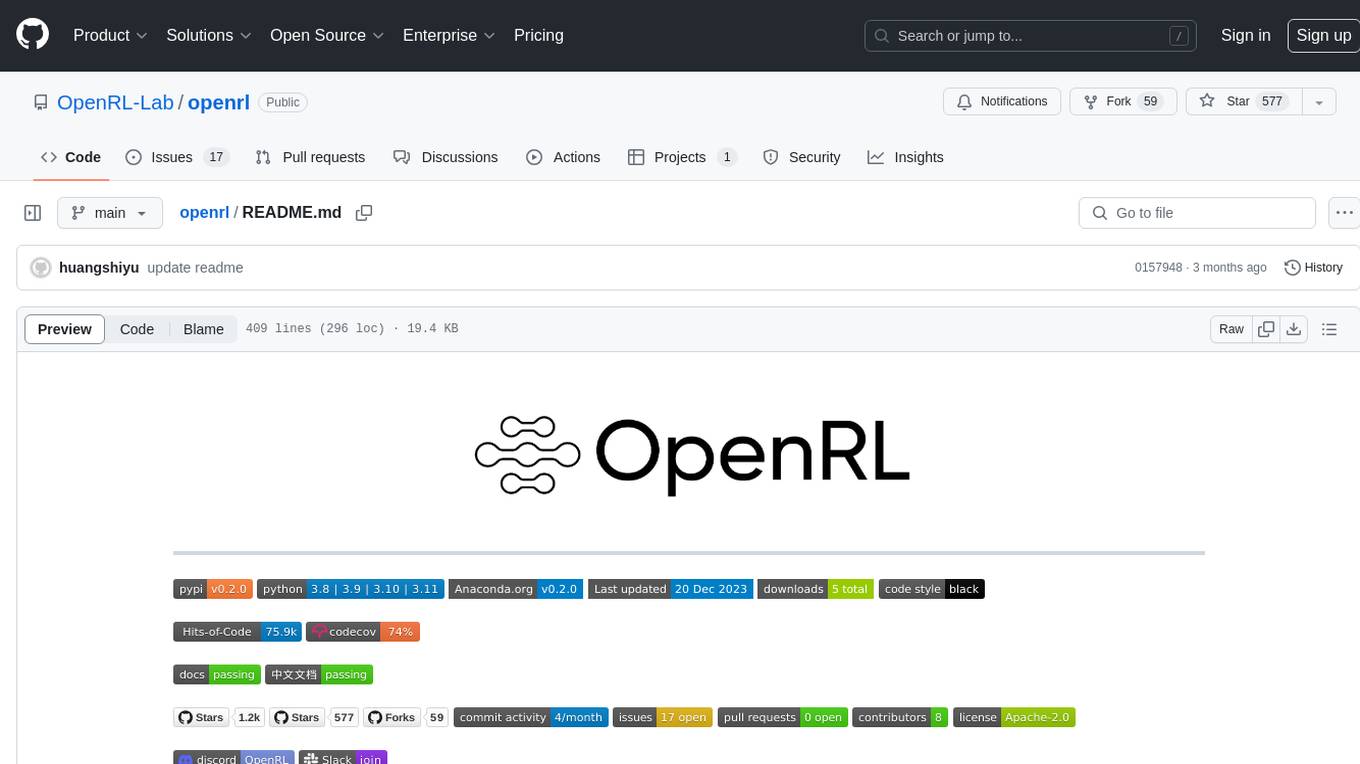
openrl
OpenRL is an open-source general reinforcement learning research framework that supports training for various tasks such as single-agent, multi-agent, offline RL, self-play, and natural language. Developed based on PyTorch, the goal of OpenRL is to provide a simple-to-use, flexible, efficient and sustainable platform for the reinforcement learning research community. It supports a universal interface for all tasks/environments, single-agent and multi-agent tasks, offline RL training with expert dataset, self-play training, reinforcement learning training for natural language tasks, DeepSpeed, Arena for evaluation, importing models and datasets from Hugging Face, user-defined environments, models, and datasets, gymnasium environments, callbacks, visualization tools, unit testing, and code coverage testing. It also supports various algorithms like PPO, DQN, SAC, and environments like Gymnasium, MuJoCo, Atari, and more.
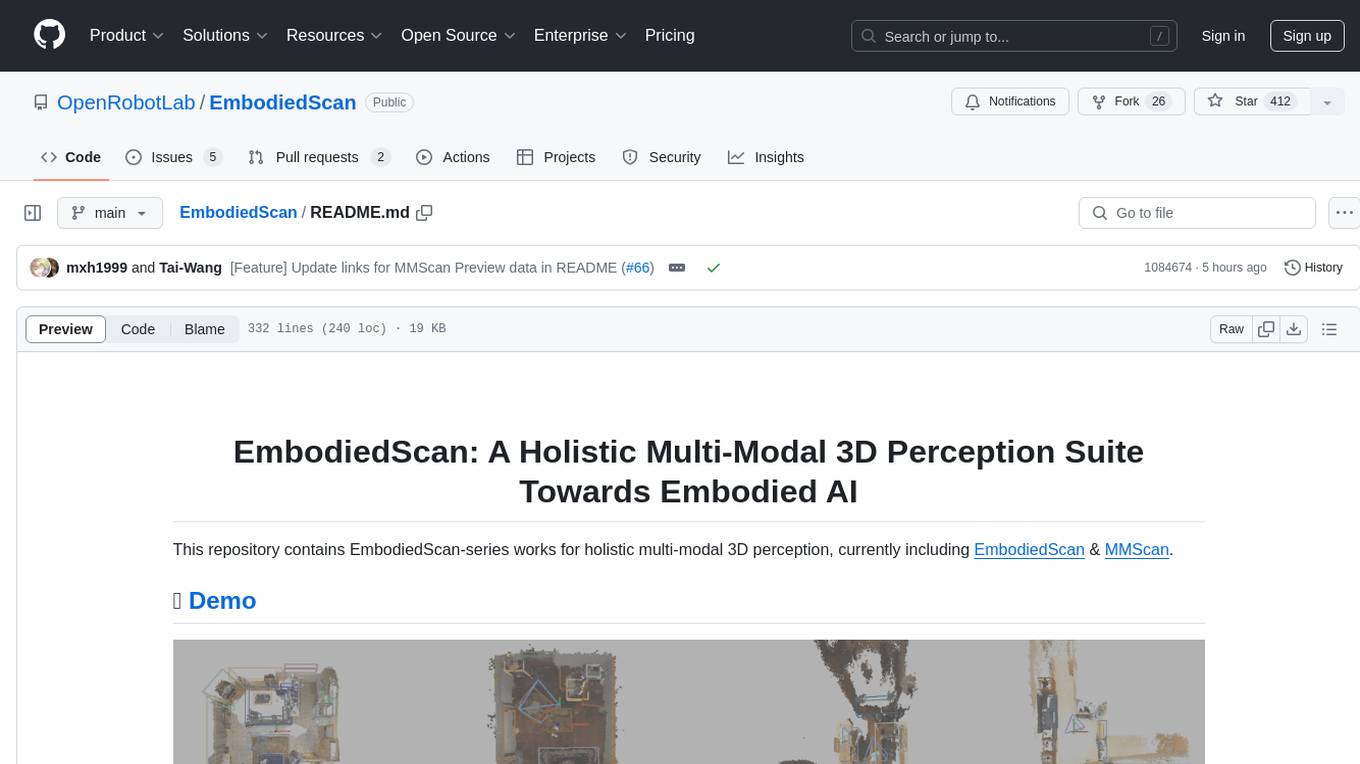
EmbodiedScan
EmbodiedScan is a holistic multi-modal 3D perception suite designed for embodied AI. It introduces a multi-modal, ego-centric 3D perception dataset and benchmark for holistic 3D scene understanding. The dataset includes over 5k scans with 1M ego-centric RGB-D views, 1M language prompts, 160k 3D-oriented boxes spanning 760 categories, and dense semantic occupancy with 80 common categories. The suite includes a baseline framework named Embodied Perceptron, capable of processing multi-modal inputs for 3D perception tasks and language-grounded tasks.
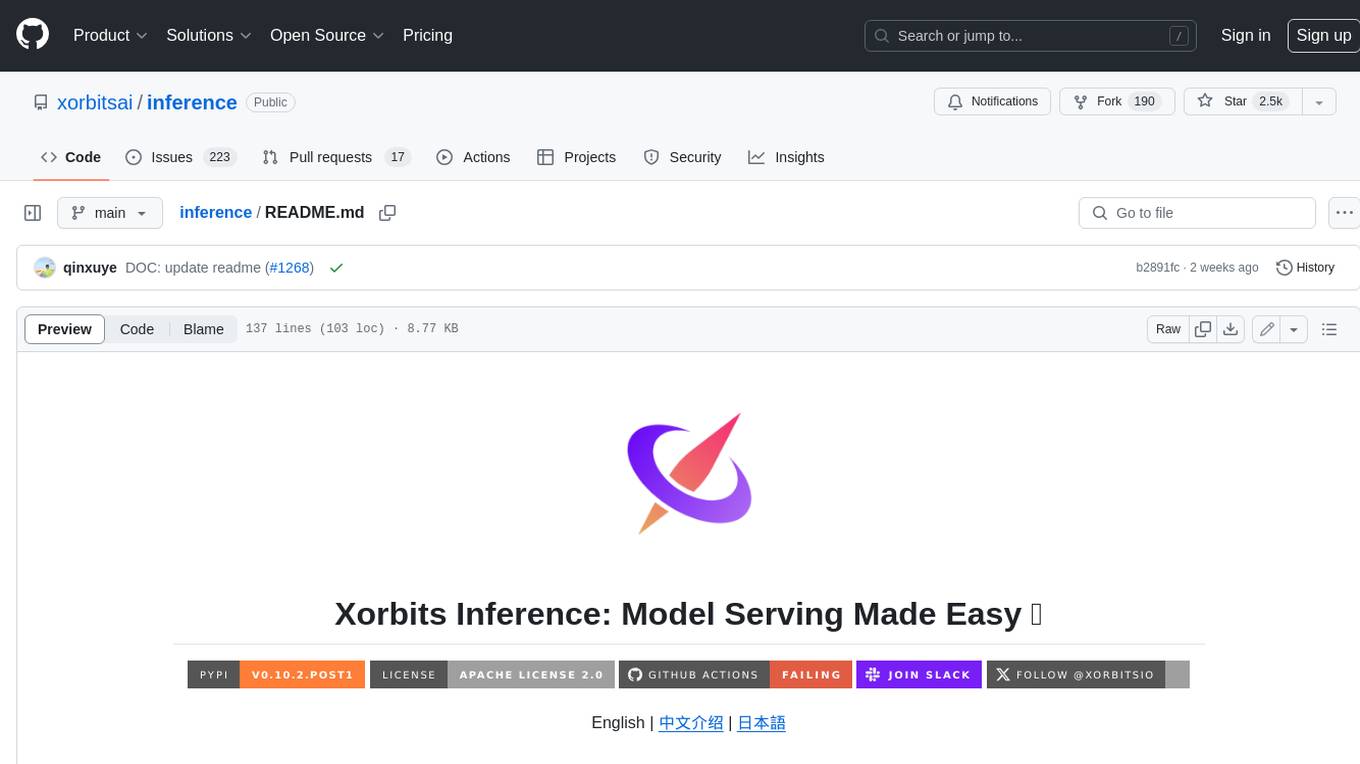
inference
Xorbits Inference (Xinference) is a powerful and versatile library designed to serve language, speech recognition, and multimodal models. With Xorbits Inference, you can effortlessly deploy and serve your or state-of-the-art built-in models using just a single command. Whether you are a researcher, developer, or data scientist, Xorbits Inference empowers you to unleash the full potential of cutting-edge AI models.
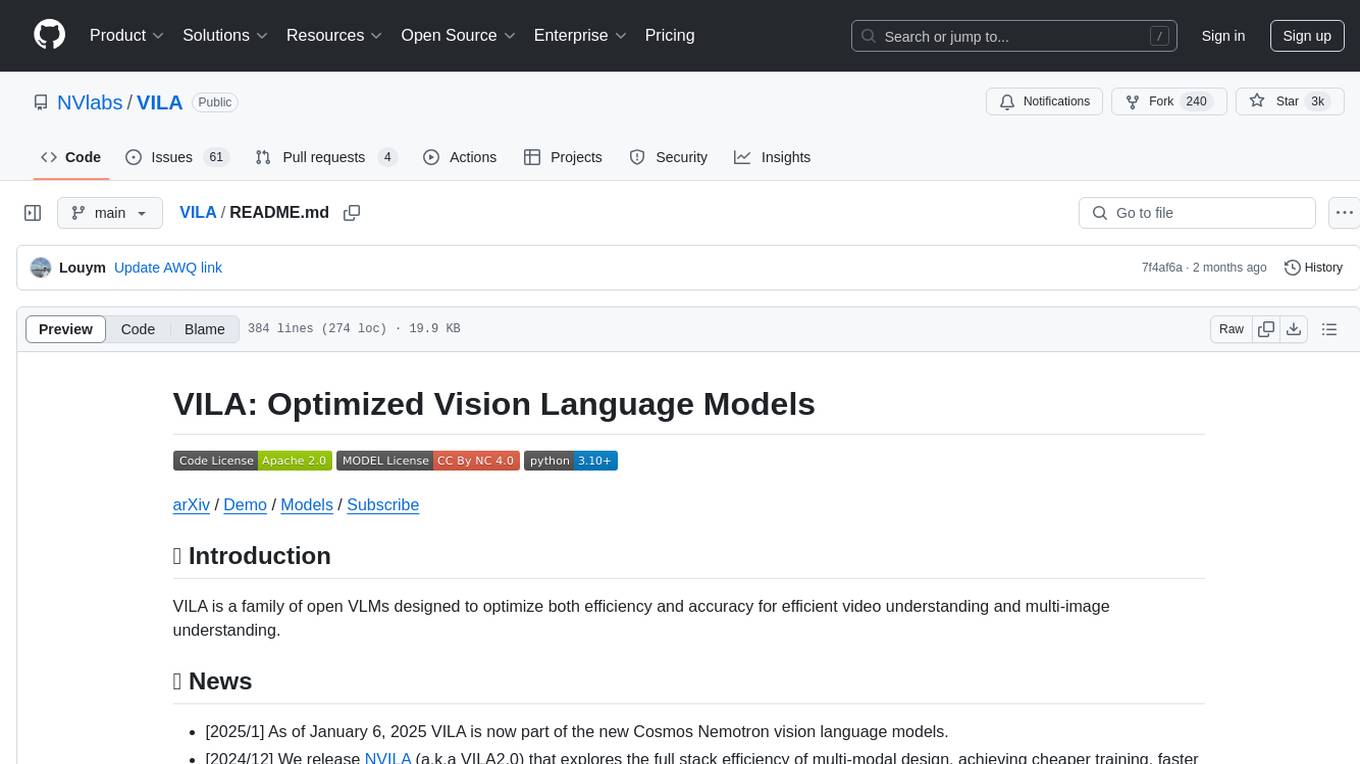
VILA
VILA is a family of open Vision Language Models optimized for efficient video understanding and multi-image understanding. It includes models like NVILA, LongVILA, VILA-M3, VILA-U, and VILA-1.5, each offering specific features and capabilities. The project focuses on efficiency, accuracy, and performance in various tasks related to video, image, and language understanding and generation. VILA models are designed to be deployable on diverse NVIDIA GPUs and support long-context video understanding, medical applications, and multi-modal design.
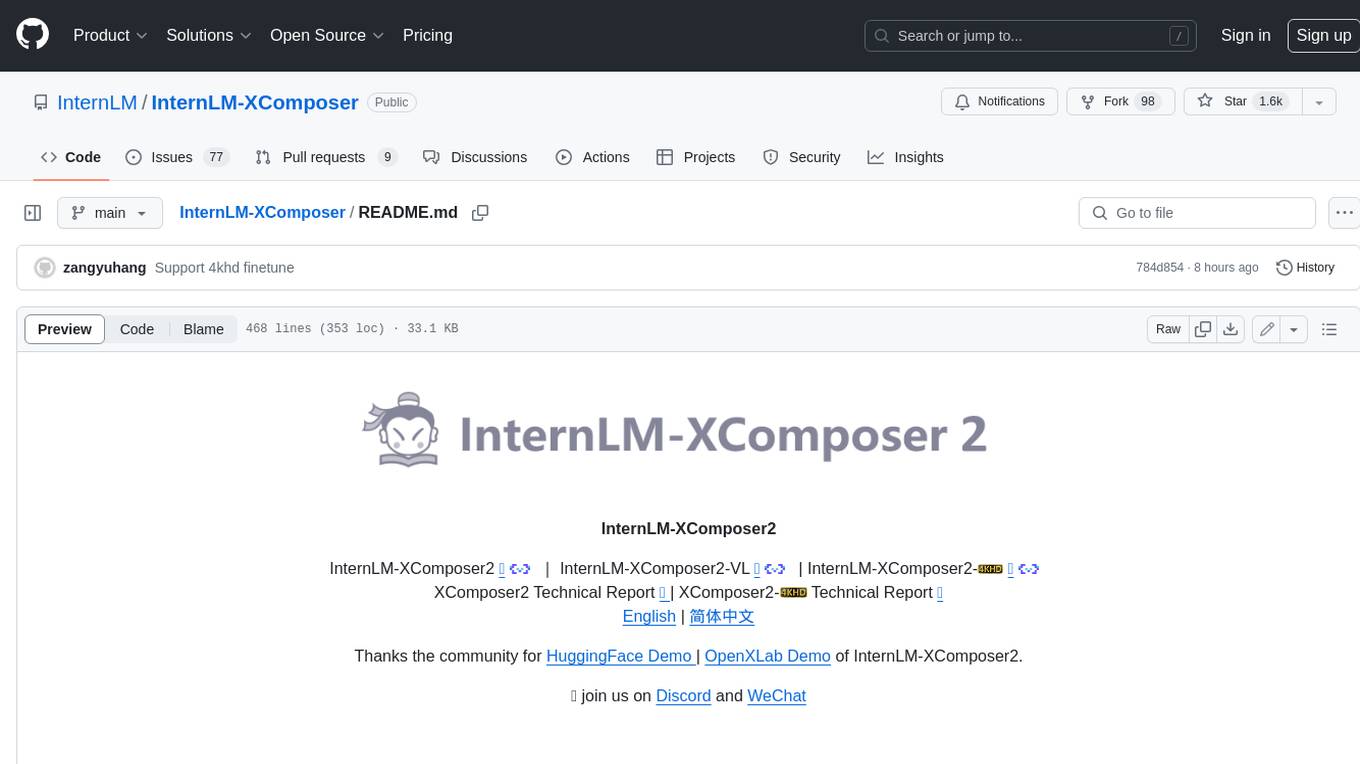
InternLM-XComposer
InternLM-XComposer2 is a groundbreaking vision-language large model (VLLM) based on InternLM2-7B excelling in free-form text-image composition and comprehension. It boasts several amazing capabilities and applications: * **Free-form Interleaved Text-Image Composition** : InternLM-XComposer2 can effortlessly generate coherent and contextual articles with interleaved images following diverse inputs like outlines, detailed text requirements and reference images, enabling highly customizable content creation. * **Accurate Vision-language Problem-solving** : InternLM-XComposer2 accurately handles diverse and challenging vision-language Q&A tasks based on free-form instructions, excelling in recognition, perception, detailed captioning, visual reasoning, and more. * **Awesome performance** : InternLM-XComposer2 based on InternLM2-7B not only significantly outperforms existing open-source multimodal models in 13 benchmarks but also **matches or even surpasses GPT-4V and Gemini Pro in 6 benchmarks** We release InternLM-XComposer2 series in three versions: * **InternLM-XComposer2-4KHD-7B** 🤗: The high-resolution multi-task trained VLLM model with InternLM-7B as the initialization of the LLM for _High-resolution understanding_ , _VL benchmarks_ and _AI assistant_. * **InternLM-XComposer2-VL-7B** 🤗 : The multi-task trained VLLM model with InternLM-7B as the initialization of the LLM for _VL benchmarks_ and _AI assistant_. **It ranks as the most powerful vision-language model based on 7B-parameter level LLMs, leading across 13 benchmarks.** * **InternLM-XComposer2-VL-1.8B** 🤗 : A lightweight version of InternLM-XComposer2-VL based on InternLM-1.8B. * **InternLM-XComposer2-7B** 🤗: The further instruction tuned VLLM for _Interleaved Text-Image Composition_ with free-form inputs. Please refer to Technical Report and 4KHD Technical Reportfor more details.
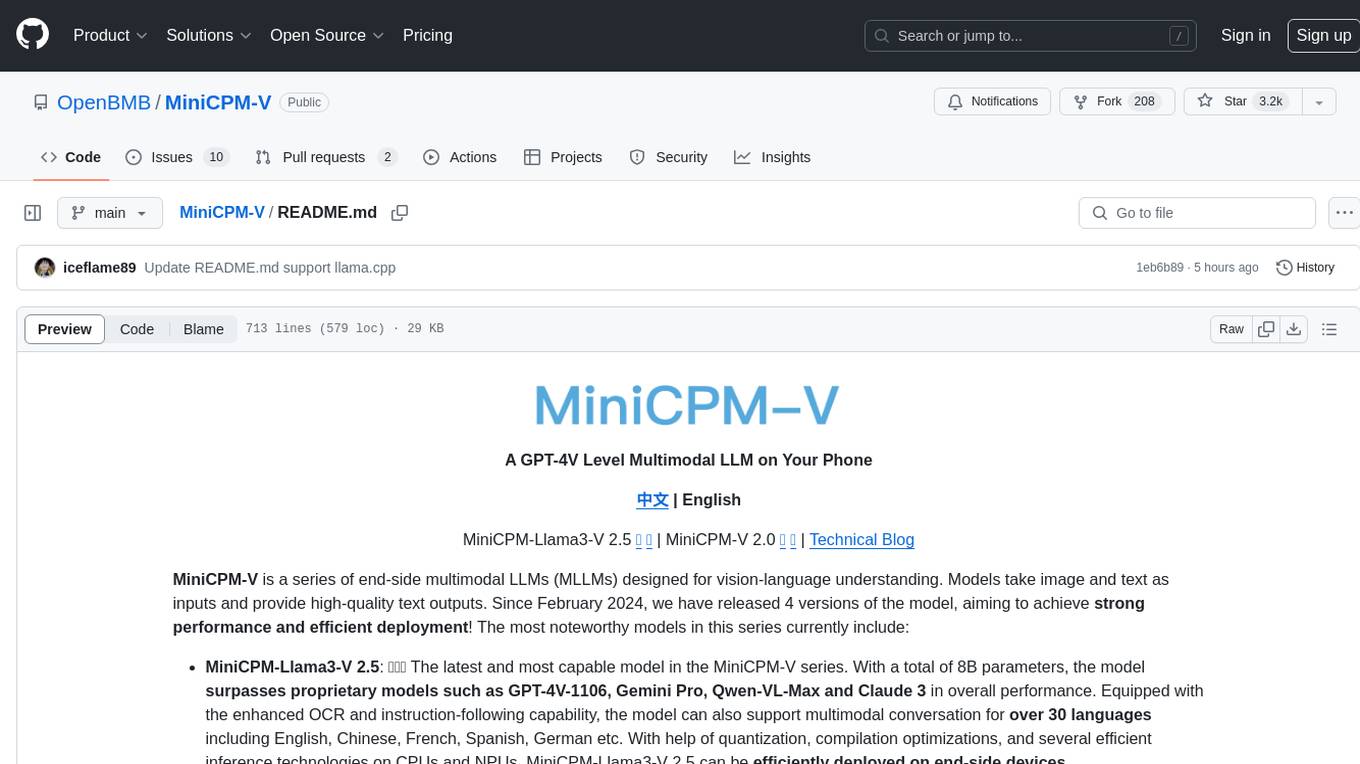
MiniCPM-V
MiniCPM-V is a series of end-side multimodal LLMs designed for vision-language understanding. The models take image and text inputs to provide high-quality text outputs. The series includes models like MiniCPM-Llama3-V 2.5 with 8B parameters surpassing proprietary models, and MiniCPM-V 2.0, a lighter model with 2B parameters. The models support over 30 languages, efficient deployment on end-side devices, and have strong OCR capabilities. They achieve state-of-the-art performance on various benchmarks and prevent hallucinations in text generation. The models can process high-resolution images efficiently and support multilingual capabilities.
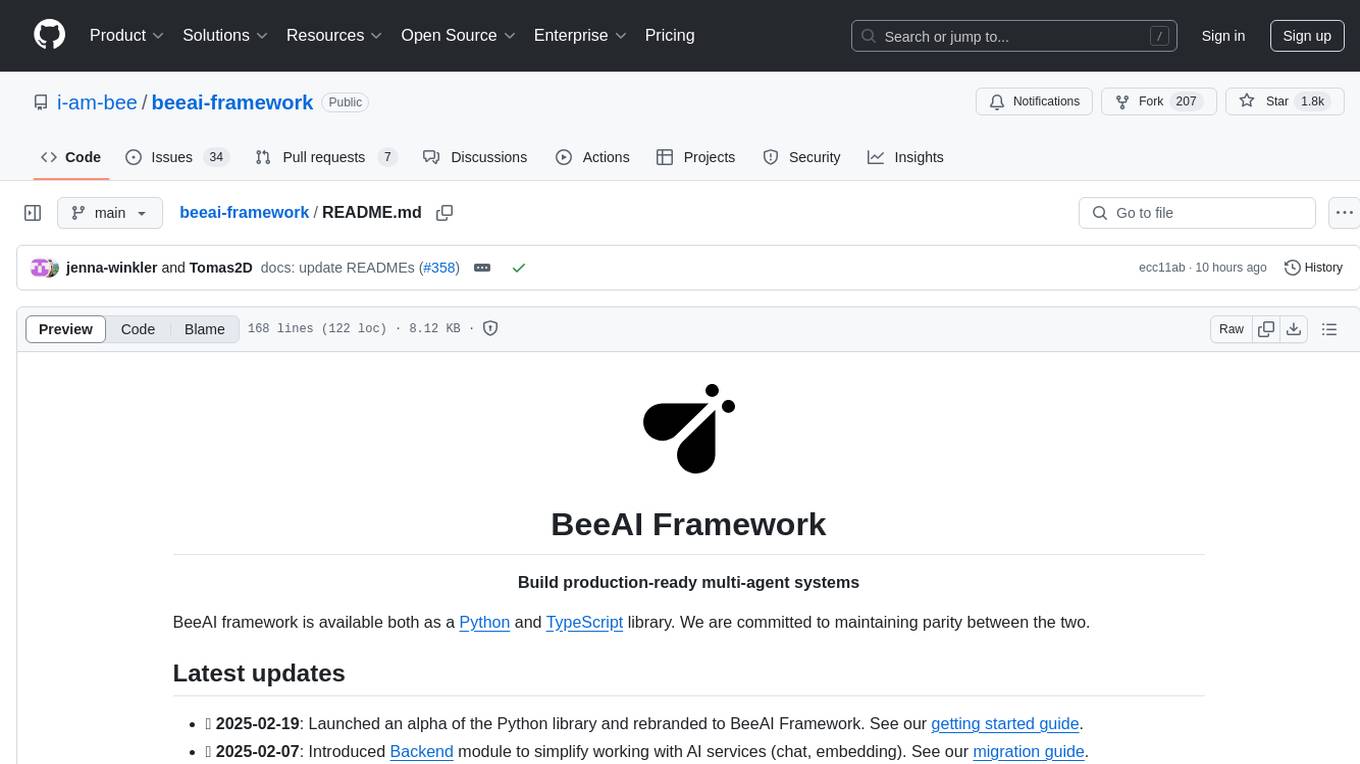
beeai-framework
BeeAI Framework is a versatile tool for building production-ready multi-agent systems. It offers flexibility in orchestrating agents, seamless integration with various models and tools, and production-grade controls for scaling. The framework supports Python and TypeScript libraries, enabling users to implement simple to complex multi-agent patterns, connect with AI services, and optimize token usage and resource management.
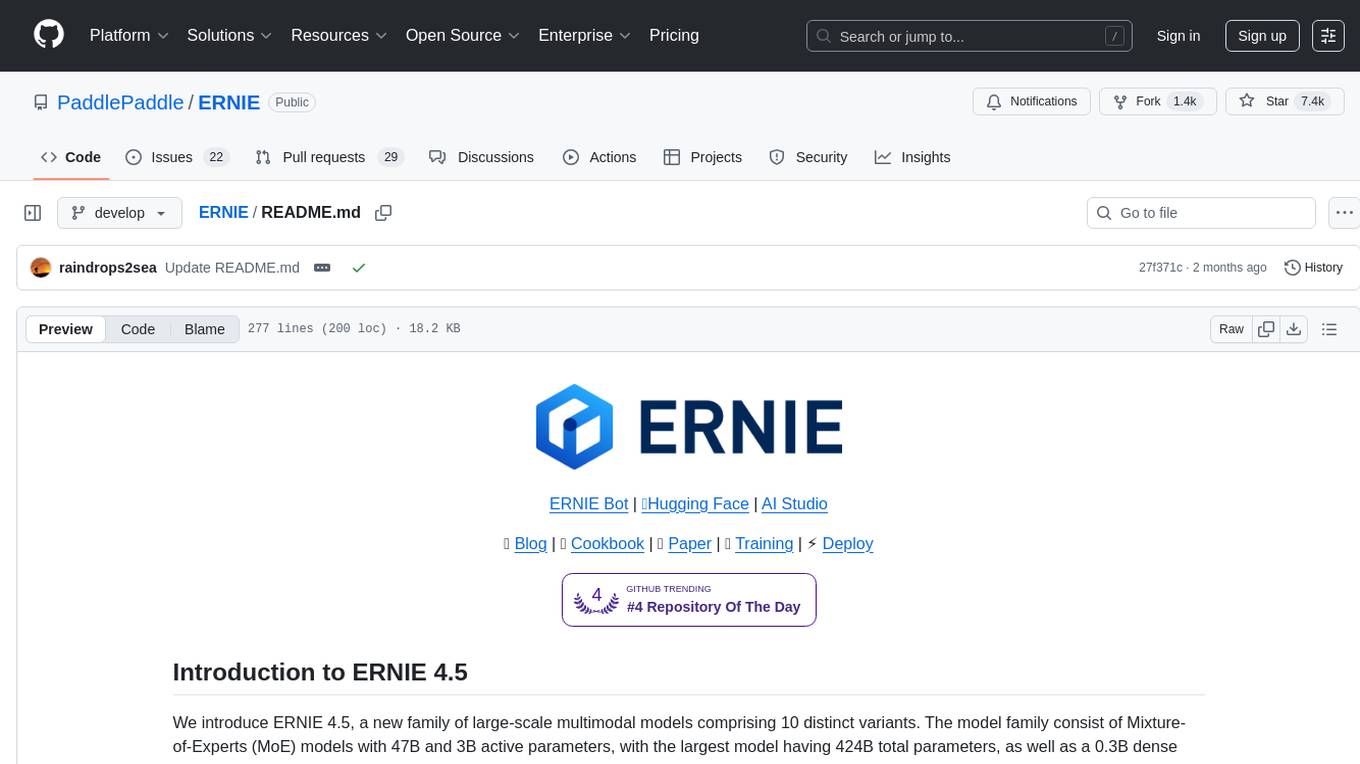
ERNIE
ERNIE 4.5 is a family of large-scale multimodal models with 10 distinct variants, including Mixture-of-Experts (MoE) models with 47B and 3B active parameters. The models feature a novel heterogeneous modality structure supporting parameter sharing across modalities while allowing dedicated parameters for each individual modality. Trained with optimal efficiency using PaddlePaddle deep learning framework, ERNIE 4.5 models achieve state-of-the-art performance across text and multimodal benchmarks, enhancing multimodal understanding without compromising performance on text-related tasks. The open-source development toolkits for ERNIE 4.5 offer industrial-grade capabilities, resource-efficient training and inference workflows, and multi-hardware compatibility.
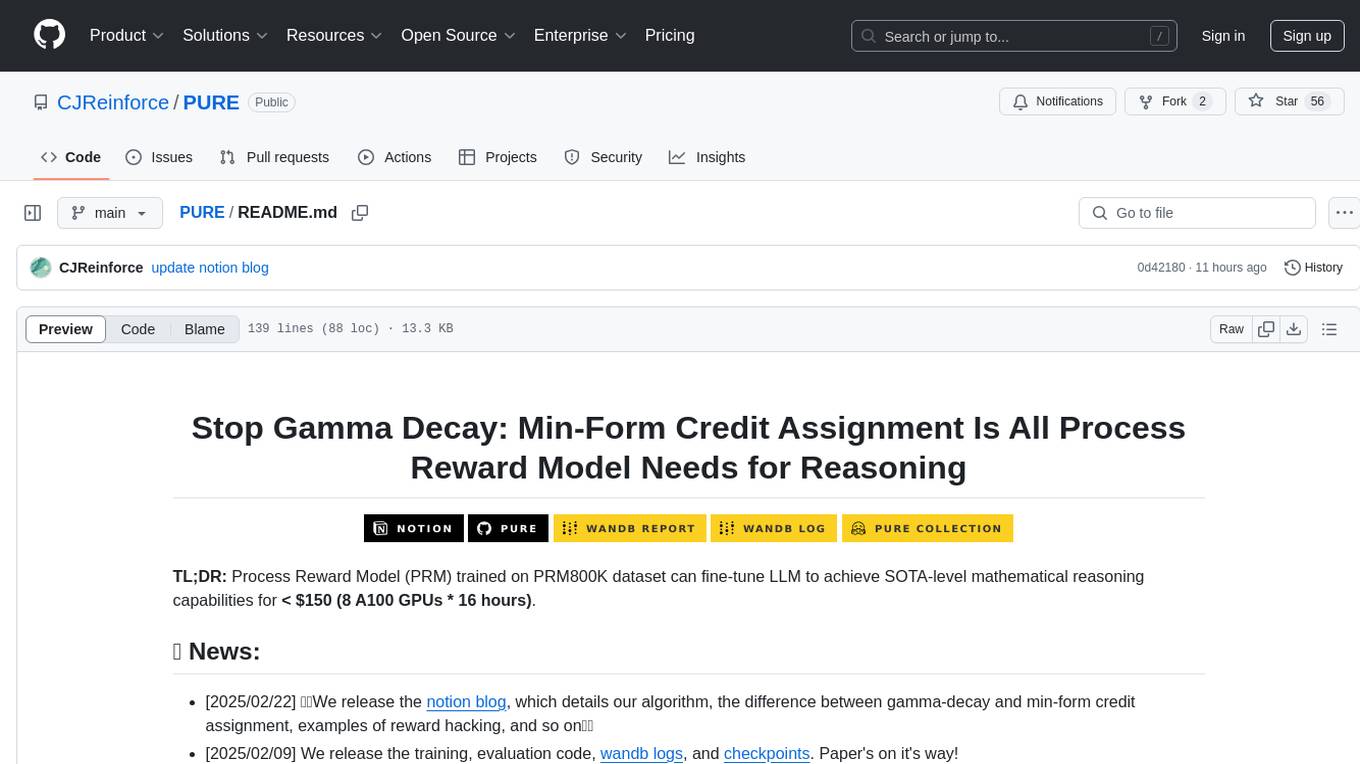
PURE
PURE (Process-sUpervised Reinforcement lEarning) is a framework that trains a Process Reward Model (PRM) on a dataset and fine-tunes a language model to achieve state-of-the-art mathematical reasoning capabilities. It uses a novel credit assignment method to calculate return and supports multiple reward types. The final model outperforms existing methods with minimal RL data or compute resources, achieving high accuracy on various benchmarks. The tool addresses reward hacking issues and aims to enhance long-range decision-making and reasoning tasks using large language models.
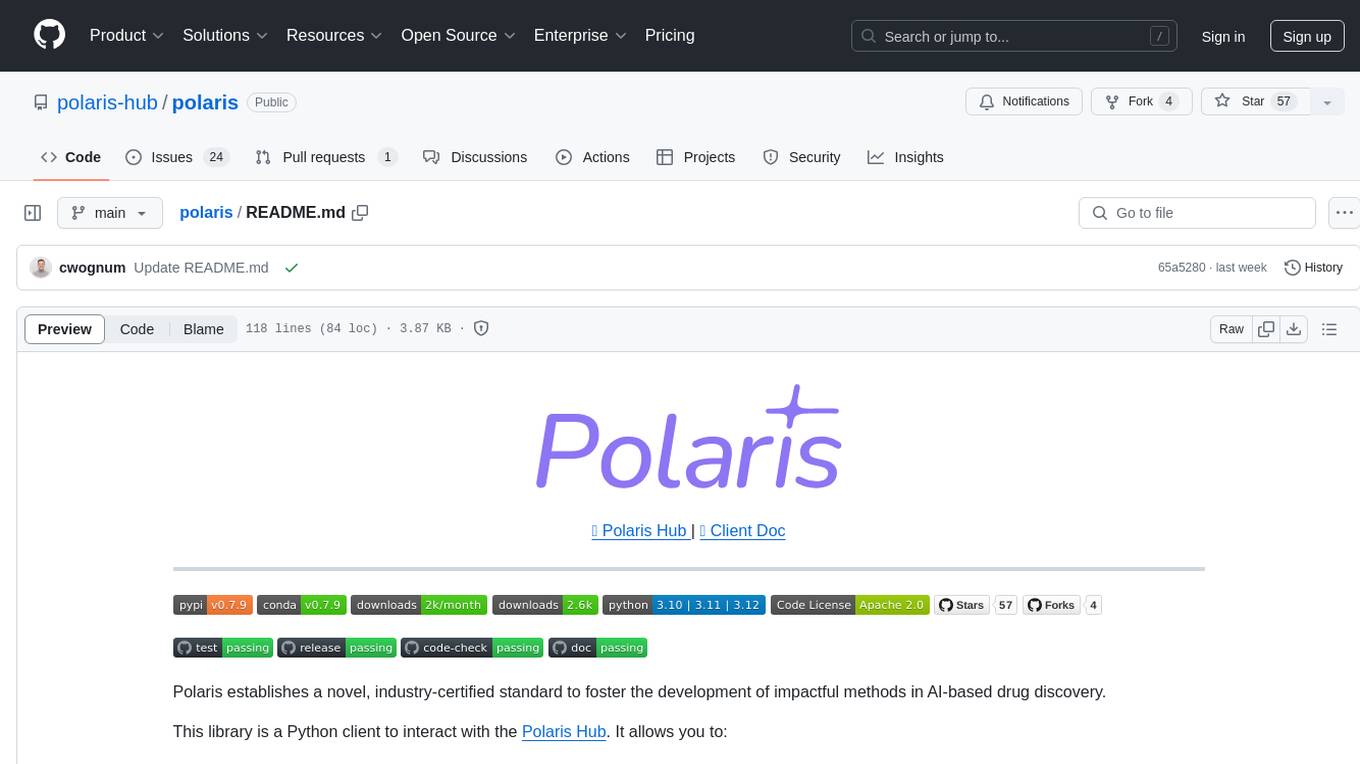
polaris
Polaris establishes a novel, industry‑certified standard to foster the development of impactful methods in AI-based drug discovery. This library is a Python client to interact with the Polaris Hub. It allows you to download Polaris datasets and benchmarks, evaluate a custom method against a Polaris benchmark, and create and upload new datasets and benchmarks.
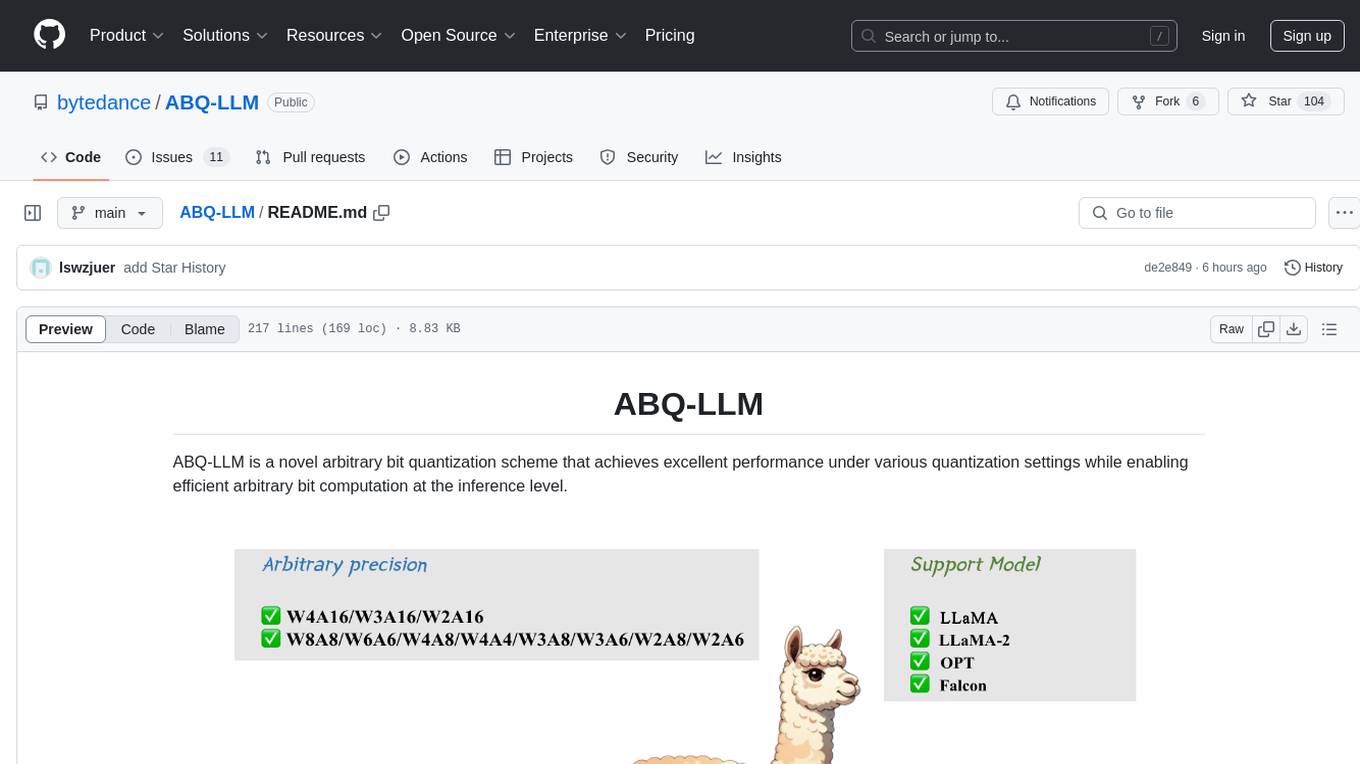
ABQ-LLM
ABQ-LLM is a novel arbitrary bit quantization scheme that achieves excellent performance under various quantization settings while enabling efficient arbitrary bit computation at the inference level. The algorithm supports precise weight-only quantization and weight-activation quantization. It provides pre-trained model weights and a set of out-of-the-box quantization operators for arbitrary bit model inference in modern architectures.
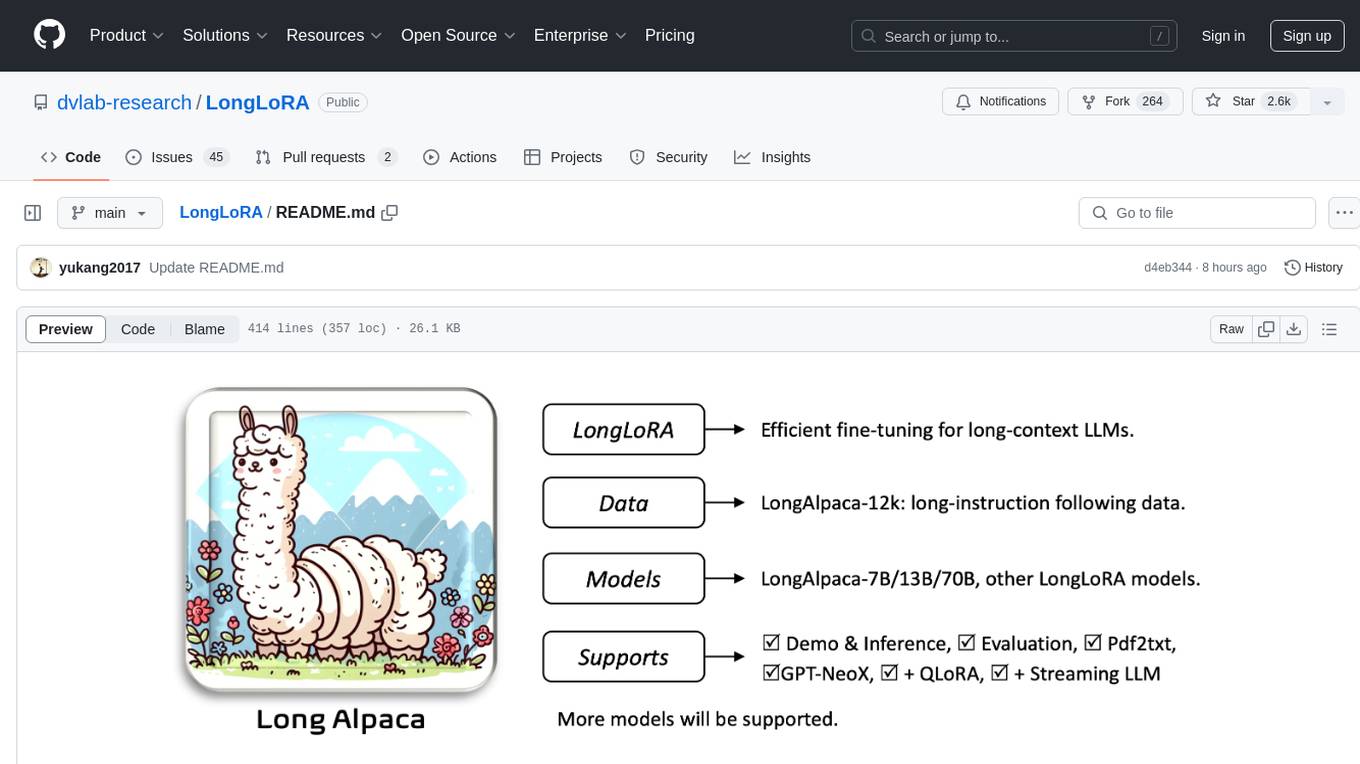
LongLoRA
LongLoRA is a tool for efficient fine-tuning of long-context large language models. It includes LongAlpaca data with long QA data collected and short QA sampled, models from 7B to 70B with context length from 8k to 100k, and support for GPTNeoX models. The tool supports supervised fine-tuning, context extension, and improved LoRA fine-tuning. It provides pre-trained weights, fine-tuning instructions, evaluation methods, local and online demos, streaming inference, and data generation via Pdf2text. LongLoRA is licensed under Apache License 2.0, while data and weights are under CC-BY-NC 4.0 License for research use only.
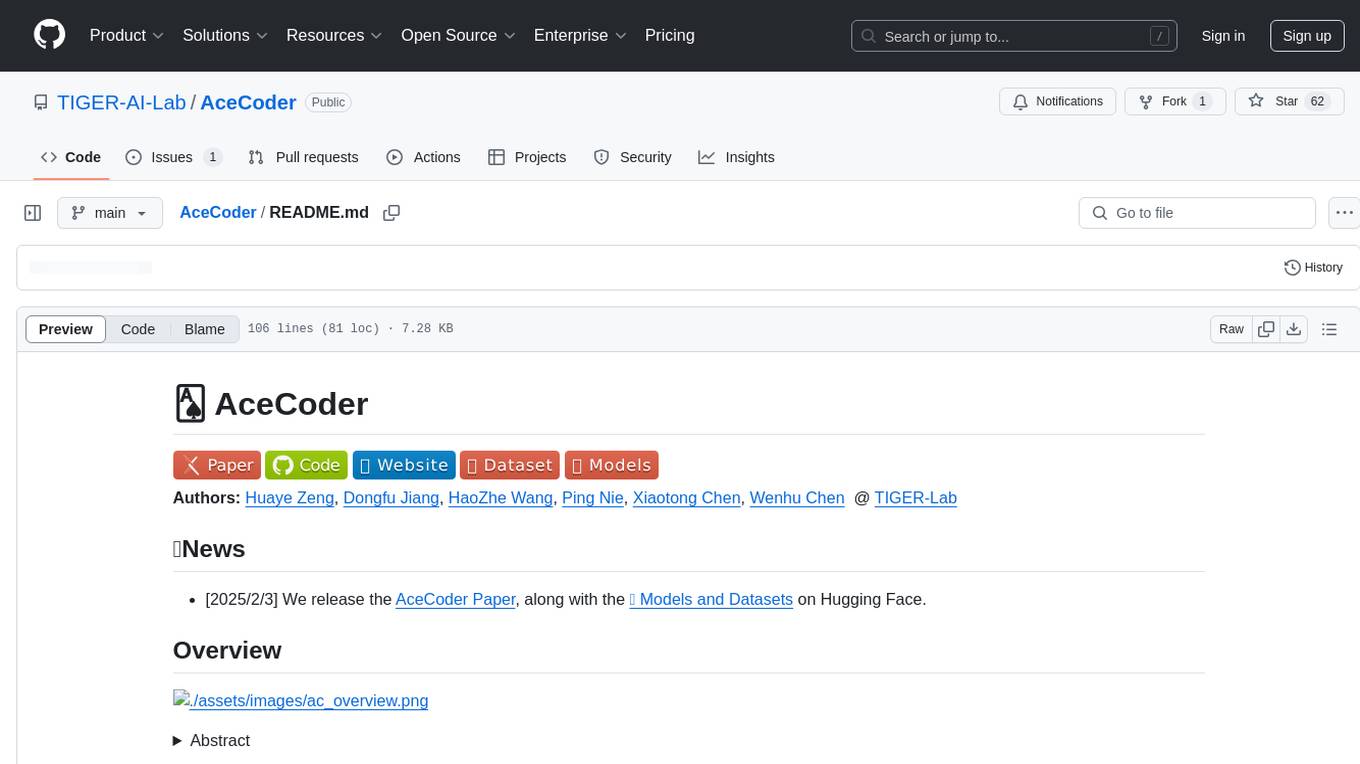
AceCoder
AceCoder is a tool that introduces a fully automated pipeline for synthesizing large-scale reliable tests used for reward model training and reinforcement learning in the coding scenario. It curates datasets, trains reward models, and performs RL training to improve coding abilities of language models. The tool aims to unlock the potential of RL training for code generation models and push the boundaries of LLM's coding abilities.
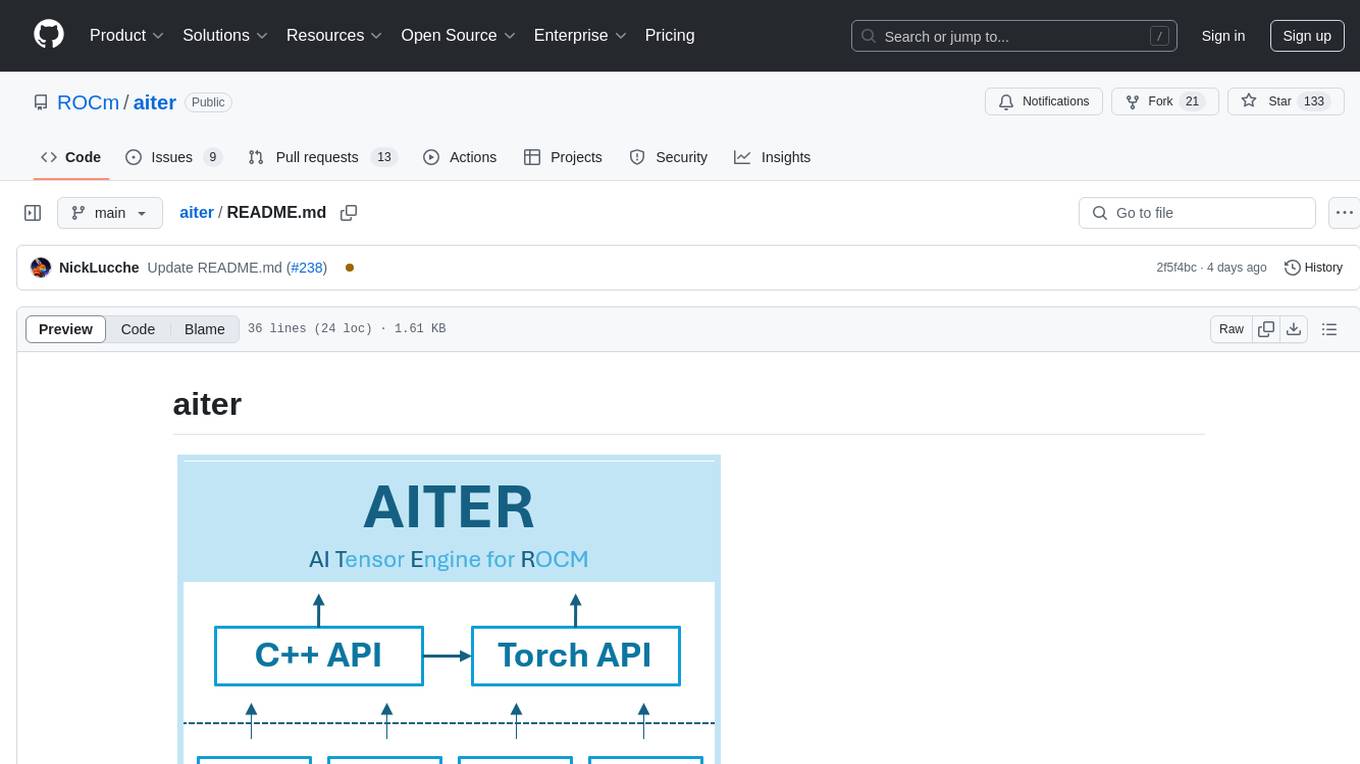
aiter
AITER is AMD’s centralized repository that supports various high performance AI operators for AI workloads acceleration. It serves as a unified platform for customer operator-level requests, catering to different customer needs. Developers can focus on operators and customers can integrate this collection into their own frameworks. Features include C++ and Python level APIs, kernels from triton/ck/asm, support for inference, training, GEMM, and communication kernels for workarounds in any kernel-framework combination for any architecture limitation.
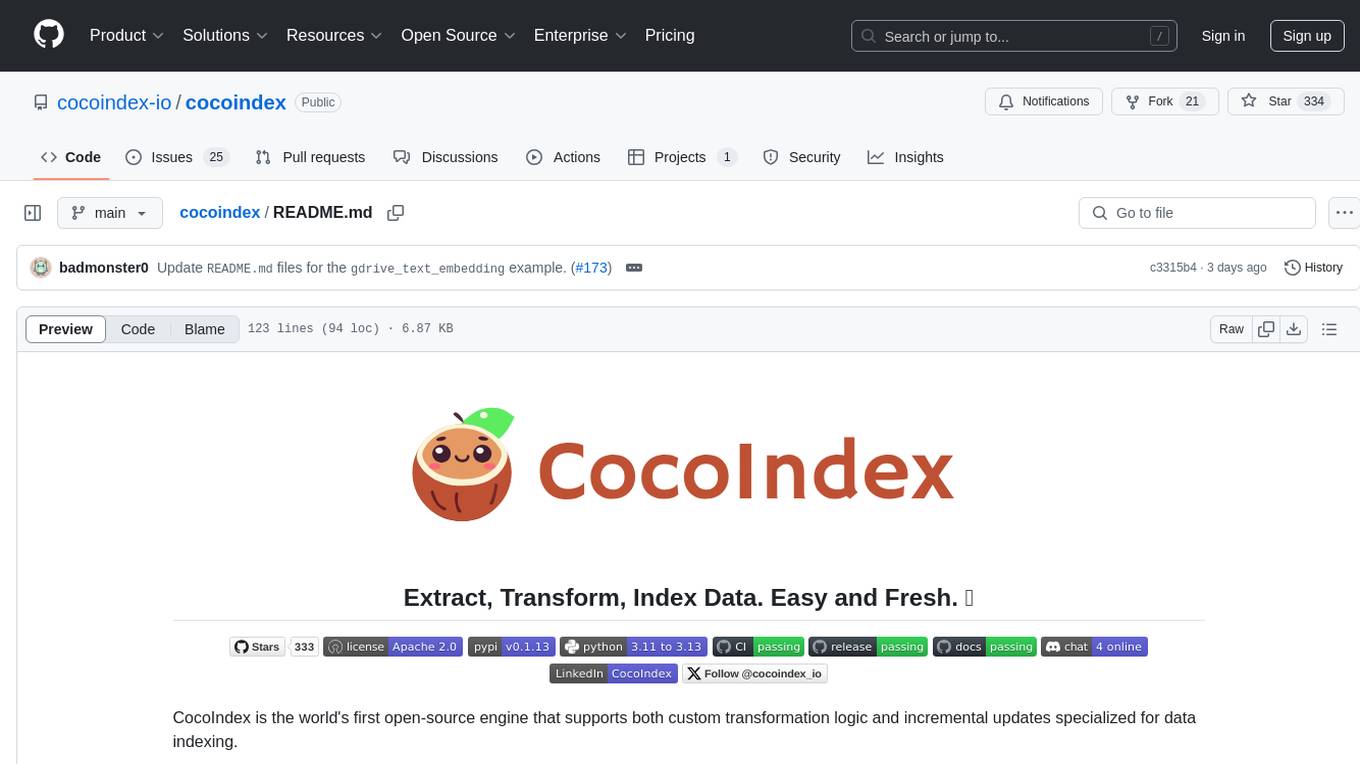
cocoindex
CocoIndex is the world's first open-source engine that supports both custom transformation logic and incremental updates specialized for data indexing. Users declare the transformation, CocoIndex creates & maintains an index, and keeps the derived index up to date based on source update, with minimal computation and changes. It provides a Python library for data indexing with features like text embedding, code embedding, PDF parsing, and more. The tool is designed to simplify the process of indexing data for semantic search and structured information extraction.
For similar tasks

LLMStack
LLMStack is a no-code platform for building generative AI agents, workflows, and chatbots. It allows users to connect their own data, internal tools, and GPT-powered models without any coding experience. LLMStack can be deployed to the cloud or on-premise and can be accessed via HTTP API or triggered from Slack or Discord.

ai-guide
This guide is dedicated to Large Language Models (LLMs) that you can run on your home computer. It assumes your PC is a lower-end, non-gaming setup.

onnxruntime-genai
ONNX Runtime Generative AI is a library that provides the generative AI loop for ONNX models, including inference with ONNX Runtime, logits processing, search and sampling, and KV cache management. Users can call a high level `generate()` method, or run each iteration of the model in a loop. It supports greedy/beam search and TopP, TopK sampling to generate token sequences, has built in logits processing like repetition penalties, and allows for easy custom scoring.
jupyter-ai
Jupyter AI connects generative AI with Jupyter notebooks. It provides a user-friendly and powerful way to explore generative AI models in notebooks and improve your productivity in JupyterLab and the Jupyter Notebook. Specifically, Jupyter AI offers: * An `%%ai` magic that turns the Jupyter notebook into a reproducible generative AI playground. This works anywhere the IPython kernel runs (JupyterLab, Jupyter Notebook, Google Colab, Kaggle, VSCode, etc.). * A native chat UI in JupyterLab that enables you to work with generative AI as a conversational assistant. * Support for a wide range of generative model providers, including AI21, Anthropic, AWS, Cohere, Gemini, Hugging Face, NVIDIA, and OpenAI. * Local model support through GPT4All, enabling use of generative AI models on consumer grade machines with ease and privacy.
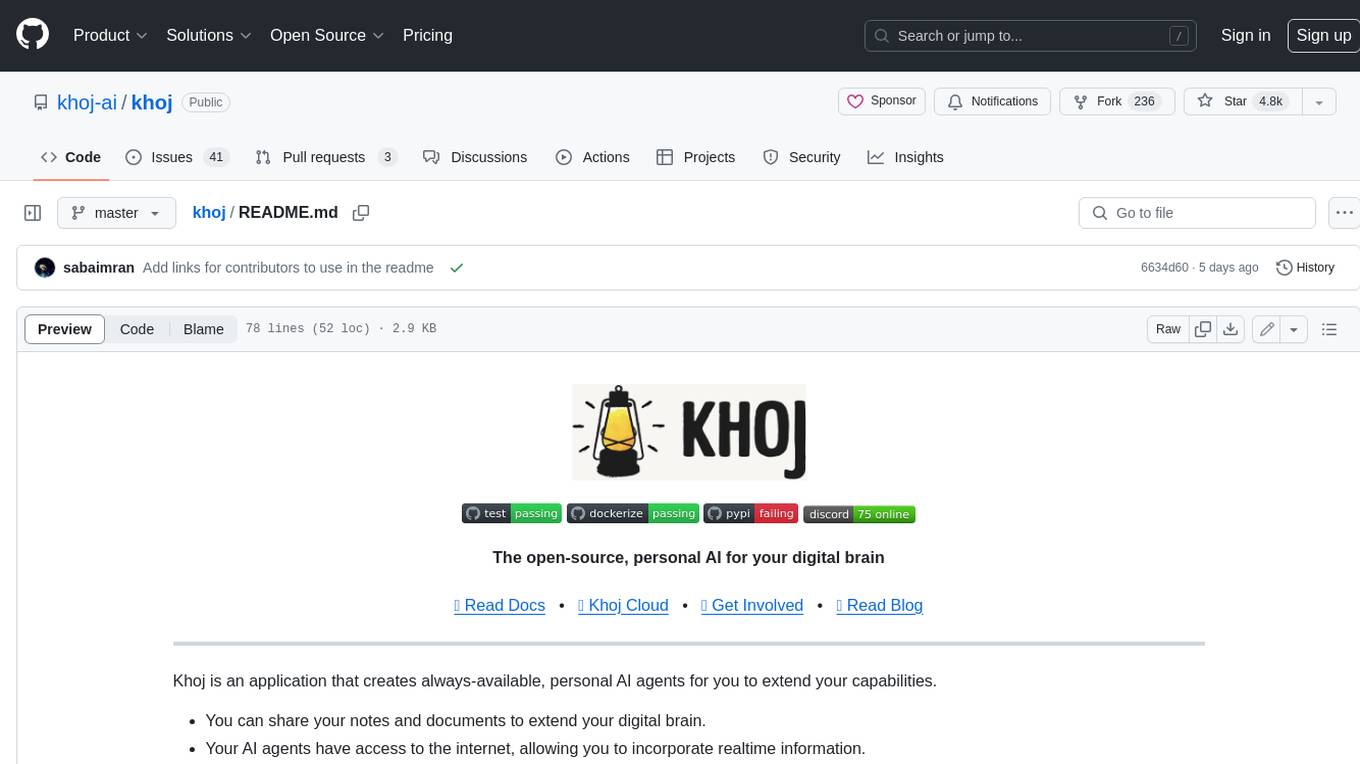
khoj
Khoj is an open-source, personal AI assistant that extends your capabilities by creating always-available AI agents. You can share your notes and documents to extend your digital brain, and your AI agents have access to the internet, allowing you to incorporate real-time information. Khoj is accessible on Desktop, Emacs, Obsidian, Web, and Whatsapp, and you can share PDF, markdown, org-mode, notion files, and GitHub repositories. You'll get fast, accurate semantic search on top of your docs, and your agents can create deeply personal images and understand your speech. Khoj is self-hostable and always will be.

langchain_dart
LangChain.dart is a Dart port of the popular LangChain Python framework created by Harrison Chase. LangChain provides a set of ready-to-use components for working with language models and a standard interface for chaining them together to formulate more advanced use cases (e.g. chatbots, Q&A with RAG, agents, summarization, extraction, etc.). The components can be grouped into a few core modules: * **Model I/O:** LangChain offers a unified API for interacting with various LLM providers (e.g. OpenAI, Google, Mistral, Ollama, etc.), allowing developers to switch between them with ease. Additionally, it provides tools for managing model inputs (prompt templates and example selectors) and parsing the resulting model outputs (output parsers). * **Retrieval:** assists in loading user data (via document loaders), transforming it (with text splitters), extracting its meaning (using embedding models), storing (in vector stores) and retrieving it (through retrievers) so that it can be used to ground the model's responses (i.e. Retrieval-Augmented Generation or RAG). * **Agents:** "bots" that leverage LLMs to make informed decisions about which available tools (such as web search, calculators, database lookup, etc.) to use to accomplish the designated task. The different components can be composed together using the LangChain Expression Language (LCEL).
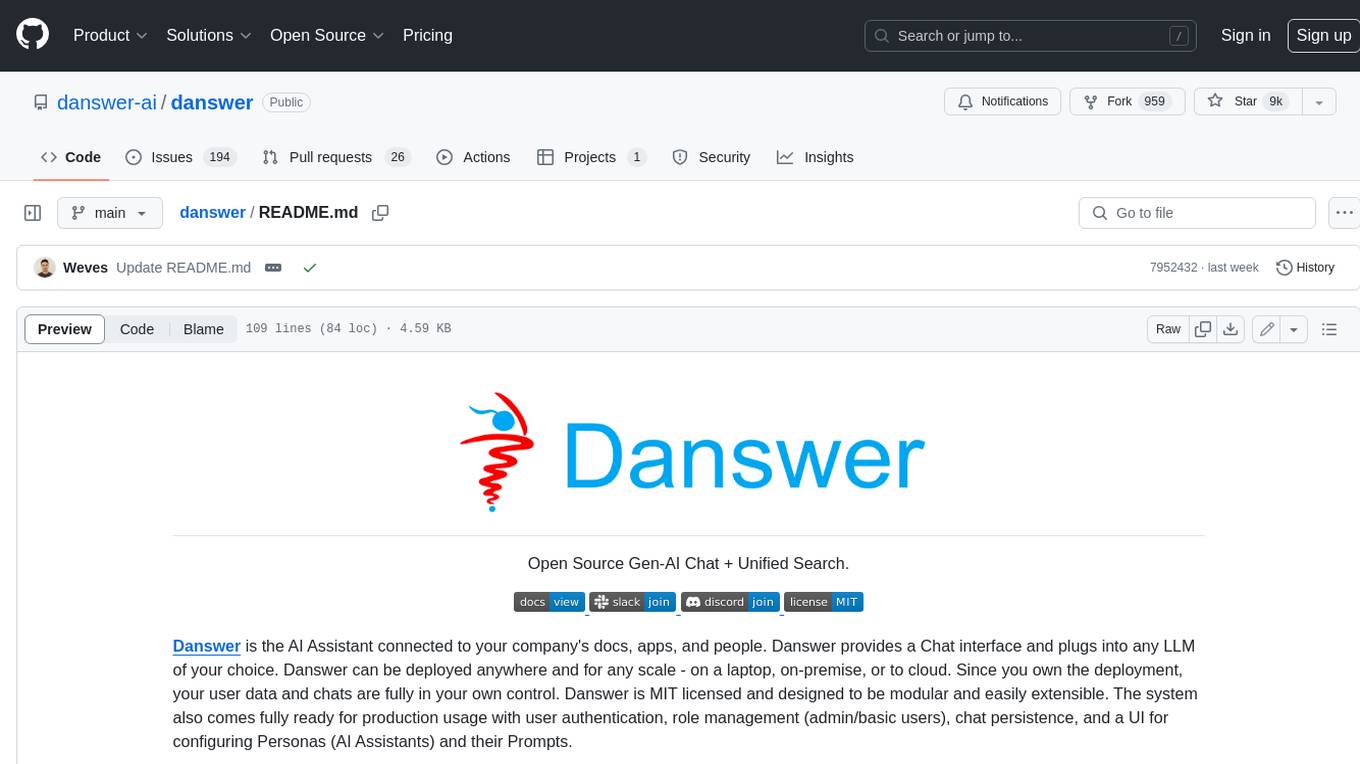
danswer
Danswer is an open-source Gen-AI Chat and Unified Search tool that connects to your company's docs, apps, and people. It provides a Chat interface and plugs into any LLM of your choice. Danswer can be deployed anywhere and for any scale - on a laptop, on-premise, or to cloud. Since you own the deployment, your user data and chats are fully in your own control. Danswer is MIT licensed and designed to be modular and easily extensible. The system also comes fully ready for production usage with user authentication, role management (admin/basic users), chat persistence, and a UI for configuring Personas (AI Assistants) and their Prompts. Danswer also serves as a Unified Search across all common workplace tools such as Slack, Google Drive, Confluence, etc. By combining LLMs and team specific knowledge, Danswer becomes a subject matter expert for the team. Imagine ChatGPT if it had access to your team's unique knowledge! It enables questions such as "A customer wants feature X, is this already supported?" or "Where's the pull request for feature Y?"
infinity
Infinity is an AI-native database designed for LLM applications, providing incredibly fast full-text and vector search capabilities. It supports a wide range of data types, including vectors, full-text, and structured data, and offers a fused search feature that combines multiple embeddings and full text. Infinity is easy to use, with an intuitive Python API and a single-binary architecture that simplifies deployment. It achieves high performance, with 0.1 milliseconds query latency on million-scale vector datasets and up to 15K QPS.
For similar jobs
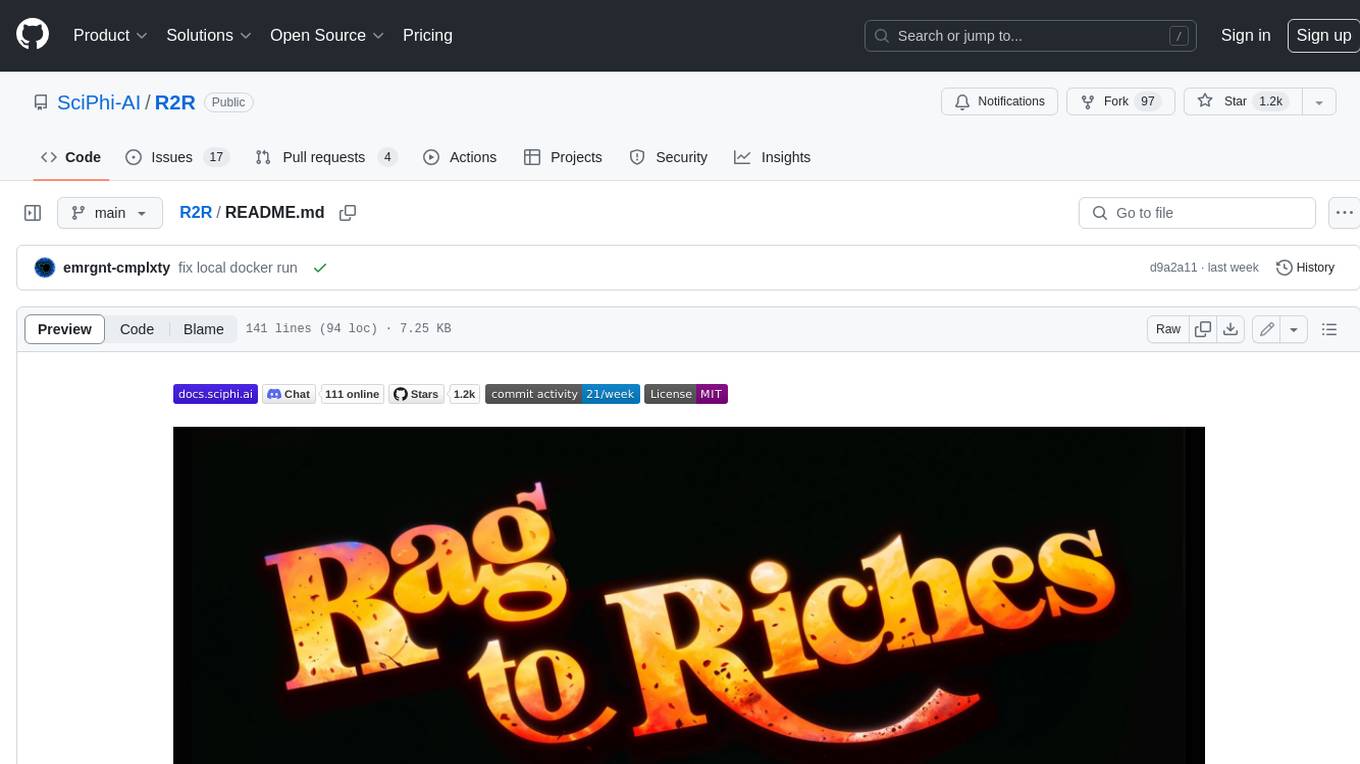
R2R
R2R (RAG to Riches) is a fast and efficient framework for serving high-quality Retrieval-Augmented Generation (RAG) to end users. The framework is designed with customizable pipelines and a feature-rich FastAPI implementation, enabling developers to quickly deploy and scale RAG-based applications. R2R was conceived to bridge the gap between local LLM experimentation and scalable production solutions. **R2R is to LangChain/LlamaIndex what NextJS is to React**. A JavaScript client for R2R deployments can be found here. ### Key Features * **🚀 Deploy** : Instantly launch production-ready RAG pipelines with streaming capabilities. * **🧩 Customize** : Tailor your pipeline with intuitive configuration files. * **🔌 Extend** : Enhance your pipeline with custom code integrations. * **⚖️ Autoscale** : Scale your pipeline effortlessly in the cloud using SciPhi. * **🤖 OSS** : Benefit from a framework developed by the open-source community, designed to simplify RAG deployment.
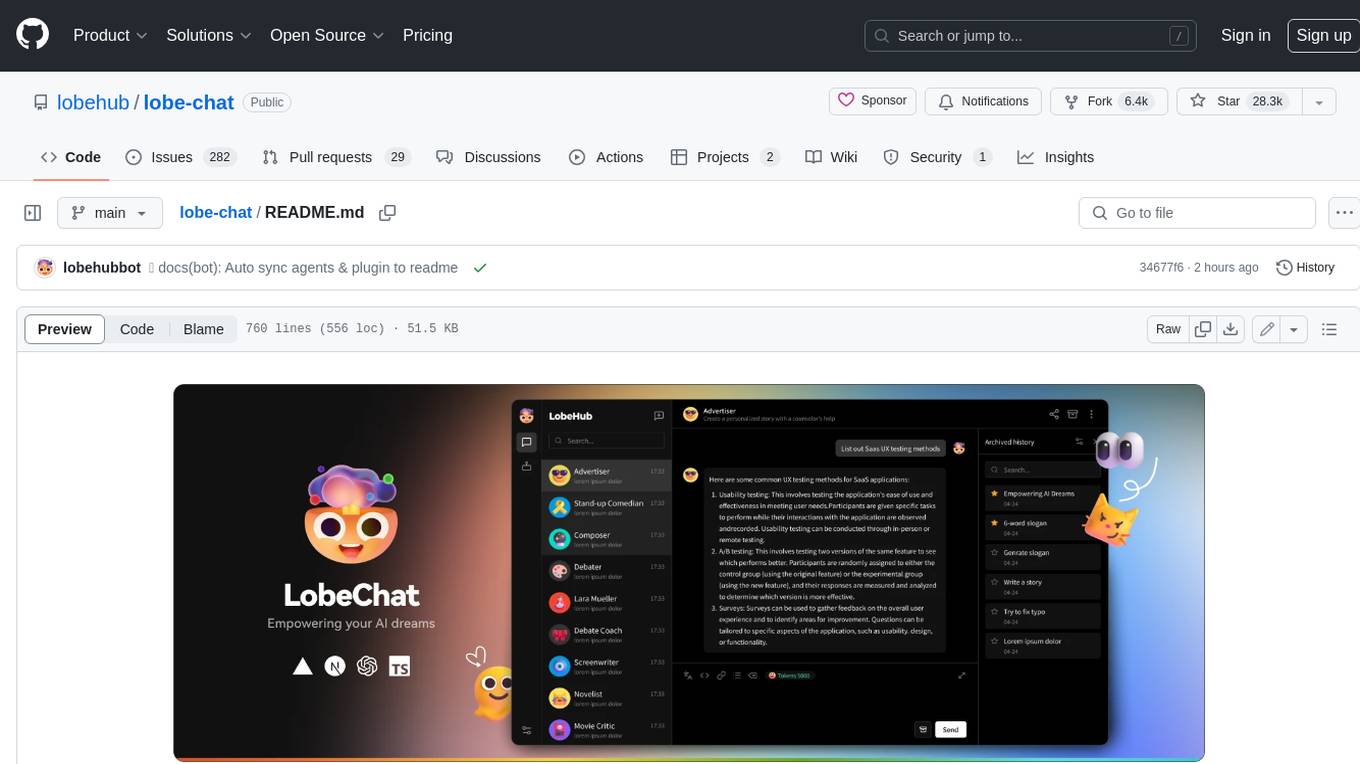
lobe-chat
Lobe Chat is an open-source, modern-design ChatGPT/LLMs UI/Framework. Supports speech-synthesis, multi-modal, and extensible ([function call][docs-functionc-call]) plugin system. One-click **FREE** deployment of your private OpenAI ChatGPT/Claude/Gemini/Groq/Ollama chat application.
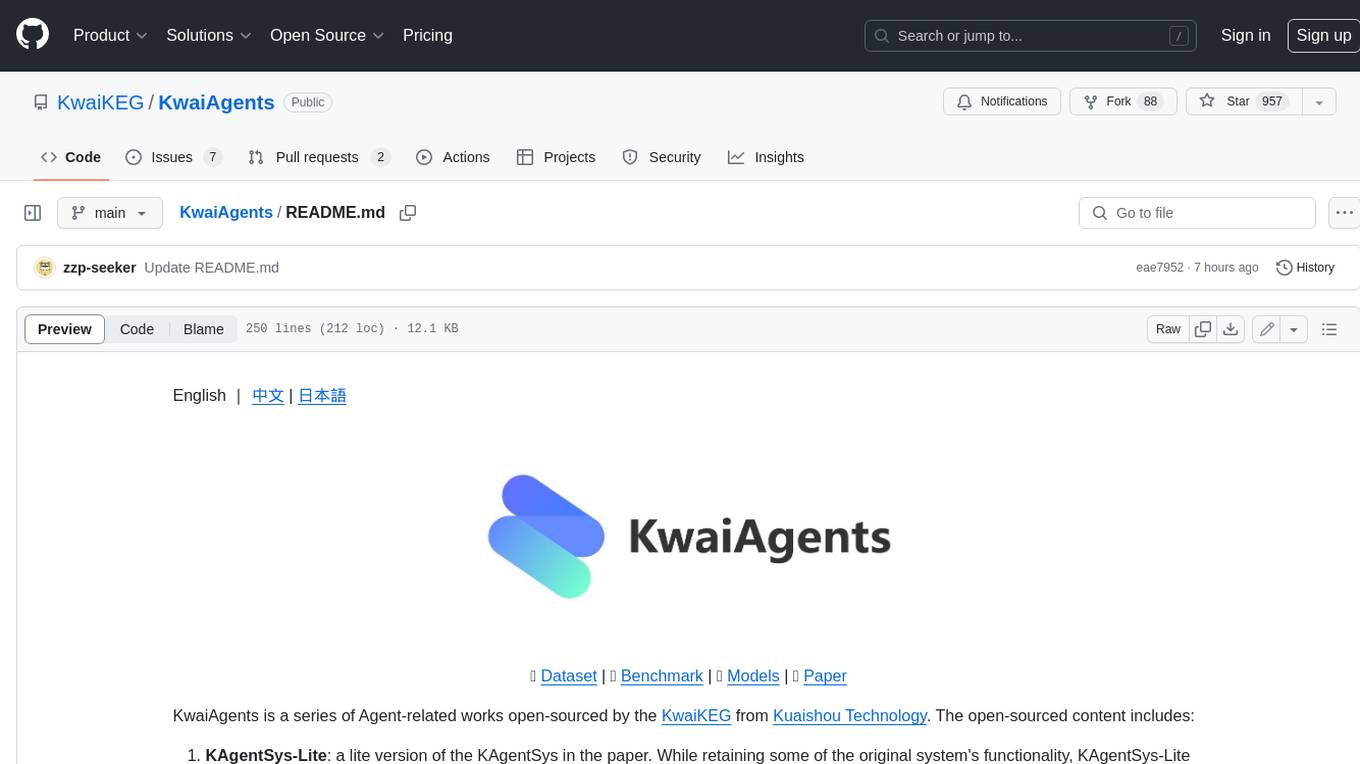
KwaiAgents
KwaiAgents is a series of Agent-related works open-sourced by the [KwaiKEG](https://github.com/KwaiKEG) from [Kuaishou Technology](https://www.kuaishou.com/en). The open-sourced content includes: 1. **KAgentSys-Lite**: a lite version of the KAgentSys in the paper. While retaining some of the original system's functionality, KAgentSys-Lite has certain differences and limitations when compared to its full-featured counterpart, such as: (1) a more limited set of tools; (2) a lack of memory mechanisms; (3) slightly reduced performance capabilities; and (4) a different codebase, as it evolves from open-source projects like BabyAGI and Auto-GPT. Despite these modifications, KAgentSys-Lite still delivers comparable performance among numerous open-source Agent systems available. 2. **KAgentLMs**: a series of large language models with agent capabilities such as planning, reflection, and tool-use, acquired through the Meta-agent tuning proposed in the paper. 3. **KAgentInstruct**: over 200k Agent-related instructions finetuning data (partially human-edited) proposed in the paper. 4. **KAgentBench**: over 3,000 human-edited, automated evaluation data for testing Agent capabilities, with evaluation dimensions including planning, tool-use, reflection, concluding, and profiling.

kimi-free-api
KIMI AI Free 服务 支持高速流式输出、支持多轮对话、支持联网搜索、支持长文档解读、支持图像解析,零配置部署,多路token支持,自动清理会话痕迹。 与ChatGPT接口完全兼容。 还有以下五个free-api欢迎关注: 阶跃星辰 (跃问StepChat) 接口转API step-free-api 阿里通义 (Qwen) 接口转API qwen-free-api ZhipuAI (智谱清言) 接口转API glm-free-api 秘塔AI (metaso) 接口转API metaso-free-api 聆心智能 (Emohaa) 接口转API emohaa-free-api

leon
Leon is an open-source personal assistant who can live on your server. He does stuff when you ask him to. You can talk to him and he can talk to you. You can also text him and he can also text you. If you want to, Leon can communicate with you by being offline to protect your privacy.

FlagEmbedding
FlagEmbedding focuses on retrieval-augmented LLMs, consisting of the following projects currently: * **Long-Context LLM** : Activation Beacon * **Fine-tuning of LM** : LM-Cocktail * **Embedding Model** : Visualized-BGE, BGE-M3, LLM Embedder, BGE Embedding * **Reranker Model** : llm rerankers, BGE Reranker * **Benchmark** : C-MTEB

Qwen
Qwen is a series of large language models developed by Alibaba DAMO Academy. It outperforms the baseline models of similar model sizes on a series of benchmark datasets, e.g., MMLU, C-Eval, GSM8K, MATH, HumanEval, MBPP, BBH, etc., which evaluate the models’ capabilities on natural language understanding, mathematic problem solving, coding, etc. Qwen models outperform the baseline models of similar model sizes on a series of benchmark datasets, e.g., MMLU, C-Eval, GSM8K, MATH, HumanEval, MBPP, BBH, etc., which evaluate the models’ capabilities on natural language understanding, mathematic problem solving, coding, etc. Qwen-72B achieves better performance than LLaMA2-70B on all tasks and outperforms GPT-3.5 on 7 out of 10 tasks.

curated-transformers
Curated Transformers is a transformer library for PyTorch that provides state-of-the-art models composed of reusable components. It supports various transformer architectures, including encoders like ALBERT, BERT, and RoBERTa, and decoders like Falcon, Llama, and MPT. The library emphasizes consistent type annotations, minimal dependencies, and ease of use for education and research. It has been production-tested by Explosion and will be the default transformer implementation in spaCy 3.7.








